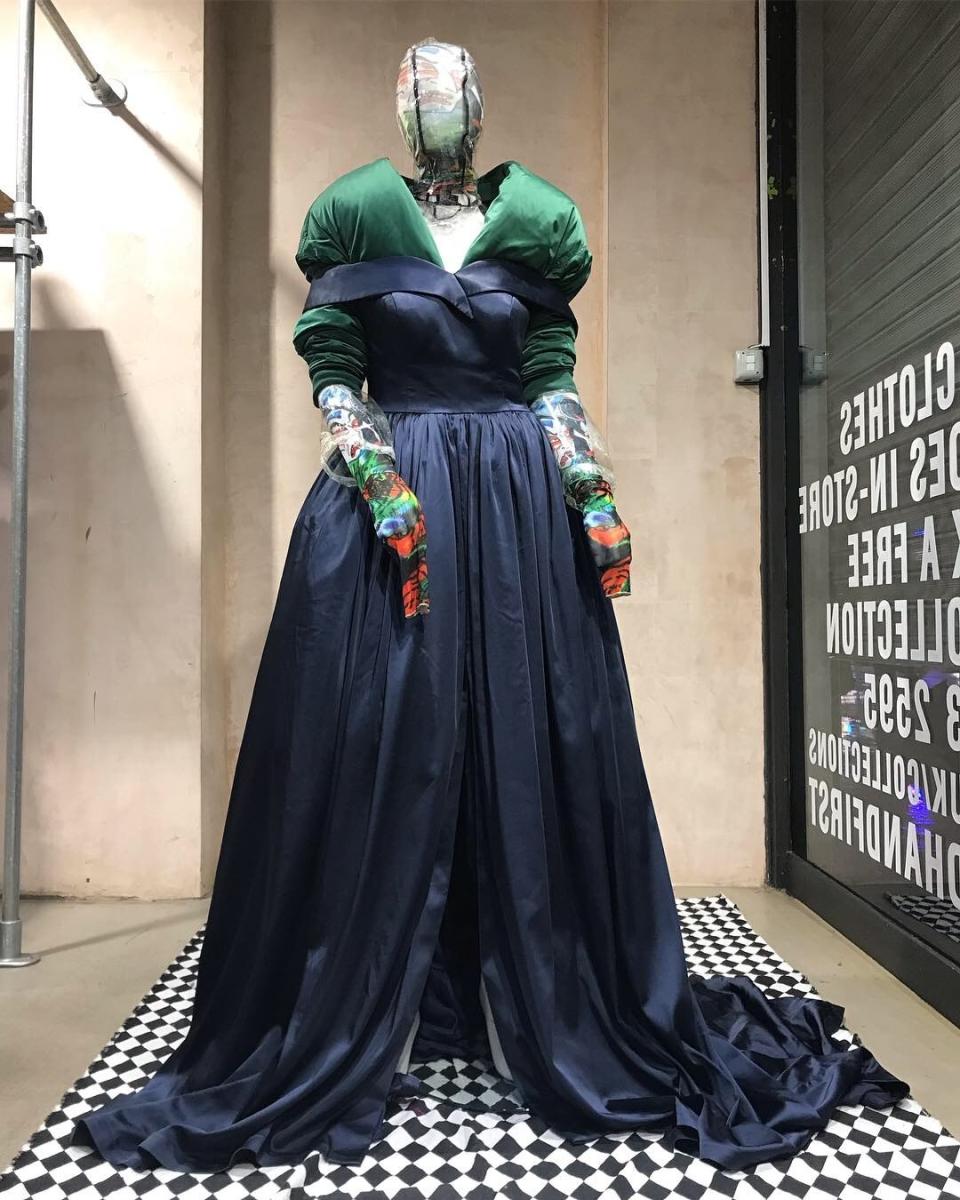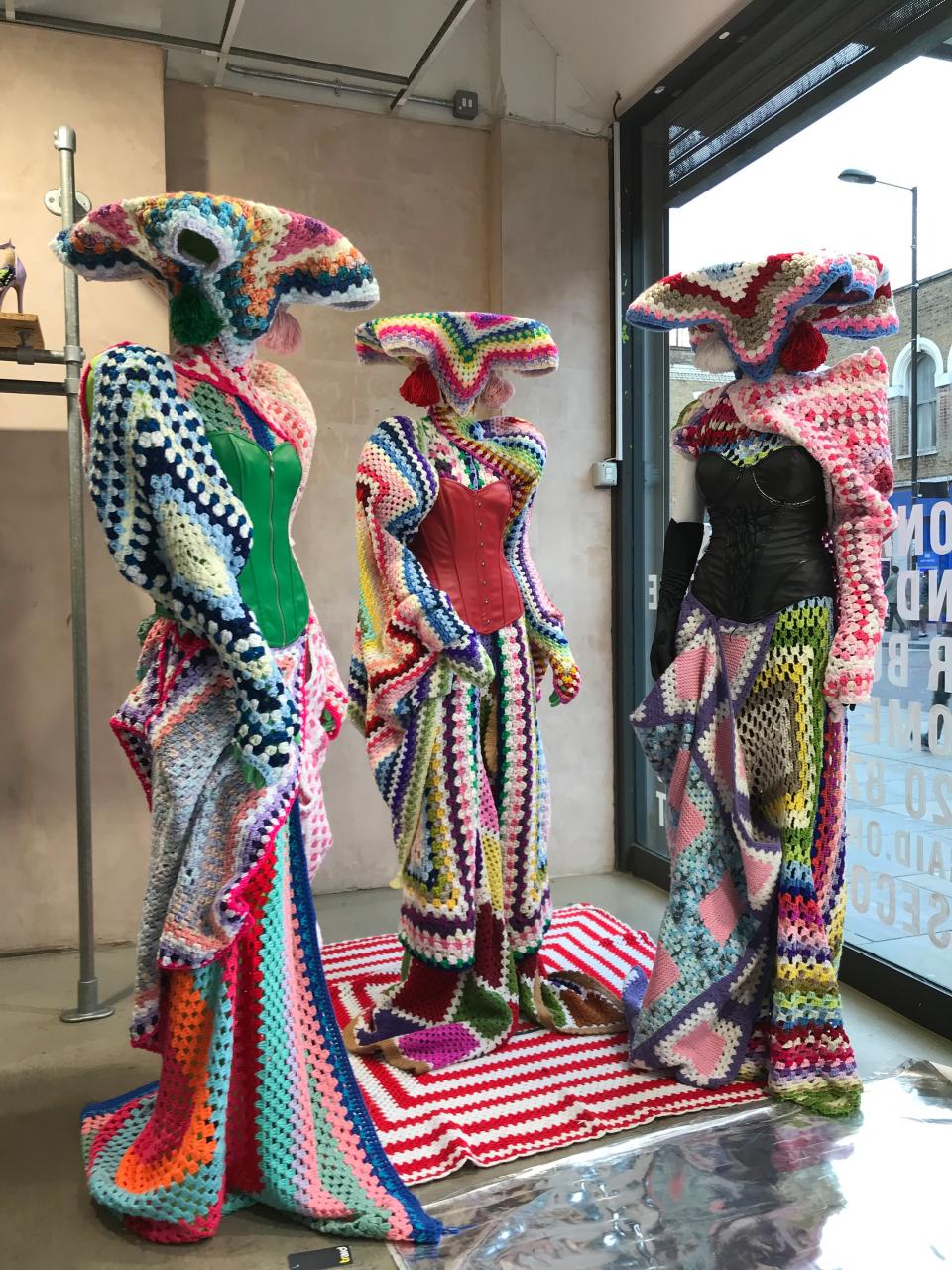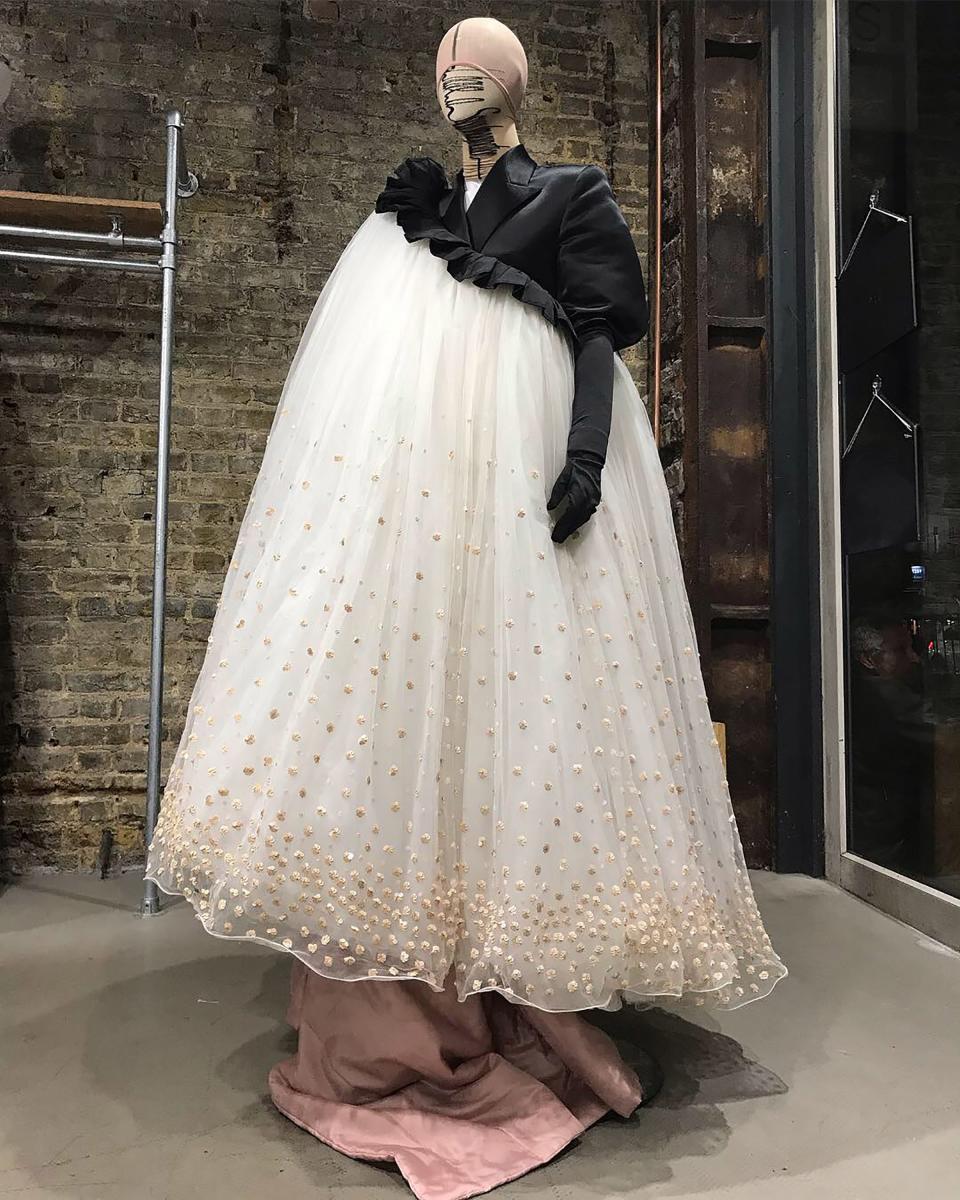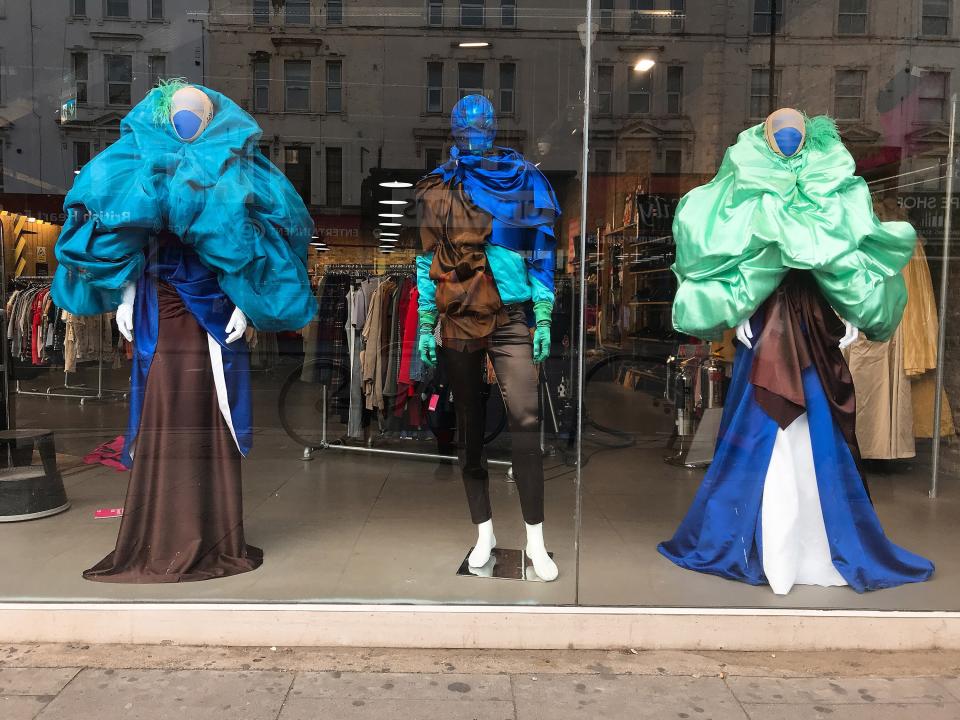Francesco Colucci Styles the Windows of Traid in London, Turning Out Some of the City’s Fiercest Looks
Francesco Colucci is an Italian living in London who creates window displays for the network of Traid thrift stores across the British capital, using whatever has been donated to this organization that tackles clothing waste. That’s the prosaic description of what Colucci does, but it doesn’t even begin to convey the visual bravura of his work, which calls to mind the love child of Leigh Bowery and Martin Margiela. Or the fact that those displays have become something to await whenever he unveils each and every new one. Since you’re likely not in London, you can follow him on Instagram at @franceso.colucci82 to see what he has been up to.
What makes Colucci worth following is the fierceness of the looks, their wit and verve, the daring way he’ll radically reconsider whatever is to hand: vintage evening dresses get layered one atop the other, like some fashion version of the princess and the pea; coats are spliced in half and then partnered with the very last thing you’d ever imagine; and granny’s pilled craftwork crochet blankets get used in such a way that you realize they have gone to a far, far better place than the spare bedroom.
You can’t buy what he creates, but then that’s not really the point. The crucial thing here is to not discard, but cut up, rethink, go wild. It’s a sustainable riposte to a fashion world that needs (let’s be honest) it’s wasteful extravagances reined in, and a call to giving in to one’s crazier impulses about how it might be fun, and original, to look. He and I had been in touch via email for a few months, but the arrival of Earth Day seemed a perfect moment to finally check in with this talented (and sincere) maverick.
Can you describe your role at Traid?
My work consists of creating window displays, expressing and fulfilling myself every day—which can be challenging as I work on the windows of 11 shops across London! I work on my own, and I love the challenge of constantly thinking of new ideas and stories. I may have an [initial] idea, but once I start to work and select the materials, my direction can change completely, evolving throughout the making process.
I consider my job as more than a stylist. I rarely deal with a final product or a label to create my work. I want the results to reflect me and the way I view things. I make use of garments, accessories, and objects that I find in the shop; these components I adapt when they are on the mannequins, working with scissors, tape, and most importantly, pins. These are the tools that make my work possible. The final results—the outfits—are fitted to the mannequins and are rarely easy to disassemble.
How did you end up doing it?
After graduating in fine art (painting) in Rome, I gained experience of contemporary art, video, and performance within the theatre. I arrived in London 9 years ago and began working at Traid as a sales assistant. After 3 years, my ability and individual style for creating windows became apparent and I was promoted to visual merchandiser, a new role in the company and a unique position within charity [thrift] shops in general. From this point the windows became my opportunity to express myself while simultaneously creating a trademark identity on the streets of London for Traid. Introducing creativity and making eye-catching window displays creates a focus for the charity and encourages support.

London’s been a constant place of reference for original and irreverent style. How does the city influence your work?
London is and always will be, in my opinion, the place where people dare, where freedom of expression comes first. It is still a nonstop source of inspiration. Working for Traid I have the privilege to show what I can do without lenses or filters. My work arrives at everything from people I see walking in the street as well as some of the extraordinary characters that I’ve met. I once bumped into Gilbert & George in Dalston, two of my favorite artists, and I was flattered to hear that they appreciate my work. Or meeting Chadd [Curry], a DJ/performer who is something of a fashion icon in London. He has become a dear friend and a very personal style reference.
Tell me about the sustainable aspects of what you do.
Traid is a charity committed to the reusing of textiles, supporting international development. Reuse, repurpose, and sustainability are key factors in today’s environmentally turbulent times; we must all do as much as we can to make it a habit to get the most out of what we already have and to share what we no longer need.
A big part of my job is to take inspiration from whatever is available in each store on the day of the setup. Sometimes it is challenging, of course, but it has helped stretch the limits of my creativity. For instance: Recently, I found myself in front of a huge pile of handmade colorful crochet. Straight away I had this vision of my mannequins as icons, all completely covered with its rich and vibrant texture.

What inspires, influences your work?
I have always been interested in art/performance, exhibitions, fashion, books , music, and photography. During my academic studies in Italy, my costume design teacher Paola Lo Sciuto introduced me to the conceptual world of performative art, and afterwards, as her assistant, I had the pleasure of working with high-level artists such as Romeo Castellucci and Bernd-Uwe Marszan, one of the main Pina Bausch dancers.
A big impact on my aesthetic was the discovery of Italian cinema. I profoundly admire costume designers Danilo Donati and Piero Tosi, and directors such as Franco Zeffirelli, Pier Paolo Pasolini, Michelangelo Antonioni, and Luchino Visconti—and not an Italian, but also the director Alejandro Jodorowsky.
Since I moved to London, my curiosity has gone even further, especially toward whatever is avant-garde and new. My recent favorite discovery is the Sadler’s Wells Theatre, certainly one of the biggest contemporary art venues nowadays. And the great inspirations at the beginning of my career were Leigh Bowery and designers such as Alexander McQueen, John Galliano, and Martin Margiela.
I can see the influence of Leigh in some of your displays; he was a genius at body exaggeration and physical distortion. How did you come across him?
I discovered Leigh Bowery back in 2006, when the British School in Rome hosted the first ever solo exhibition (in Italy) of his works. I felt straight away a bonding with his character and his life experience, the landing and growing up in a foreign country. And his vision, a controversial aesthetic at a time where art was particularly suffering. Since I’ve been in London I have met people who worked or collaborated with him, and it has only confirmed for me how influential his contribution to art has been.

What are some of the best vintage pieces you’ve worked with? And what have been some of the favorite looks you’ve created?
Working in a secondhand environment, every single donation can be unexpected and surprising. The most exciting and challenging part of my job is reassembling these surprises and giving new shapes/life to what my mannequins are wearing. It is quite rare that I use real clothes or garments in their intended shape or purpose; reinvention is both exciting and important in my work. Recently I have been obsessed with redrawing volumes, regardless of the body underneath, and I’ve found evening gowns to be really useful and versatile thanks to their layered structures. I’ve also always had a passion for masks. A big focus is creating headpieces, made by random fabrics and pieces that often overtake the whole face of the mannequin.
We’ve seen an upsurge again in the interest in vintage again. What’s the importance of that, for you?
To buy secondhand clothes or vintage in this specific environment and society allows people to spend money on something that has already been worn and gives clothes a chance to be used again, another life. It can also just be a means to find something of personal interest, something unique that allows people to spend less money on quality clothing.
We just started a campaign called “23%,” referring to the fact that 23 percent of clothes in London are unworn and reusing them dramatically reduces the carbon, water, and waste footprint of clothing consumption. I feel that of late, fashion has been offering a repetitive and standard product; I’m fascinated by the extent to which the new generation is so label/logo aware and sometimes obsessed. And it can seem that many designers are far more focused on their logo to sell their clothes than they used to be.


